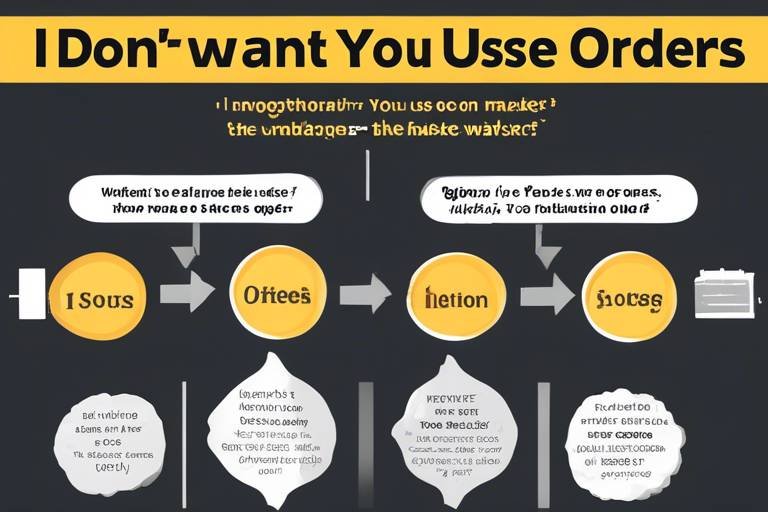Strategies for Trading on Low-Volume Days
Trading during low-volume days can feel like navigating a ship through foggy waters—uncertain, yet full of potential. When the market is characterized by low trading volume, it often leads to heightened volatility, which can be both a risk and an opportunity for savvy traders. The key is to harness effective strategies that allow you to capitalize on price movements while managing your risks effectively. In this article, we will explore various strategies tailored for low-volume trading, helping you to not only survive but thrive in these challenging conditions.
Low-volume trading days can be tricky. Picture this: fewer participants in the market mean that even a small number of trades can significantly impact stock prices. This dynamic creates an environment where prices can swing wildly, often without the usual backing of volume to stabilize them. Understanding how to operate within this framework is essential. It’s about being strategic, patient, and aware of the unique characteristics that come with trading when the market is quieter than usual.
So, how do you approach trading on these days? First, it’s crucial to recognize that low-volume days are not all doom and gloom. In fact, they can present unique opportunities for profit if you know where to look. By adapting your strategies and employing specific techniques, you can effectively navigate these waters. Let’s dive into some strategies that can help you make the most of low-volume trading days.
Low-volume trading occurs when the number of shares exchanged is significantly reduced compared to the average trading volume. This decrease in liquidity can lead to increased volatility, making it essential for traders to adapt their strategies accordingly. Understanding the characteristics of low-volume trading helps traders make better decisions and manage risks effectively. For instance, during these periods, the market may react more dramatically to news or events, leading to rapid price swings. Being aware of this can prepare you for potential market movements.
Recognizing low-volume days is crucial for traders looking to adjust their strategies. There are several ways to identify these days, including analyzing market indicators and reviewing historical data. By understanding these signals, you can prepare yourself for the unique challenges and opportunities that low-volume days present.
One of the most effective ways to identify low-volume conditions is through various market indicators. These indicators can provide insights into potential price movements, helping you make informed decisions. For example, the Volume Oscillator measures the difference between two volume moving averages, allowing traders to identify trends and potential reversals. Additionally, calculating the Average Daily Volume over a specific period can help you benchmark current trading activity against historical norms. By understanding these indicators, you can better position yourself in the market.
Adapting your trading strategies on low-volume days is essential for mitigating risks. One effective approach is to employ scalping techniques, which involve making quick trades to secure small profits. This strategy can be particularly effective during low-volume periods, as it allows traders to take advantage of price fluctuations without holding positions for extended periods. However, it’s crucial to manage the inherent risks associated with scalping, such as slippage and execution delays.
Another important consideration is the choice between limit orders and market orders. On low-volume days, limit orders can provide more control over entry and exit points, reducing the risk of unfavorable price executions. Conversely, market orders may lead to unexpected price movements due to low liquidity. Understanding the advantages and disadvantages of each order type can significantly impact your trading success on these days.
Risk management becomes increasingly important on low-volume days. To protect your capital and minimize losses, it’s essential to implement effective strategies tailored for less liquid markets. Proper position sizing is a critical component of risk control. By determining appropriate trade sizes based on market conditions and your individual risk tolerance, you can safeguard your investments while still taking advantage of trading opportunities.
Additionally, implementing effective stop-loss strategies is vital. These techniques can help you manage your risk exposure by automatically closing positions at predetermined price levels. This approach is particularly useful in volatile environments, where prices can swing dramatically. By having a solid risk management plan in place, you can navigate low-volume trading days with confidence.
- What is low-volume trading? Low-volume trading refers to market days when the number of shares exchanged is significantly lower than average, leading to increased volatility.
- How can I identify low-volume days? You can identify low-volume days by analyzing market indicators such as the Volume Oscillator and Average Daily Volume.
- What strategies should I use on low-volume days? Effective strategies include scalping, using limit orders, and implementing strong risk management techniques.
- Why is risk management important on low-volume days? Risk management is crucial because low liquidity can lead to unexpected price movements, increasing the potential for losses.

Understanding Low-Volume Trading
Low-volume trading is a fascinating aspect of the financial markets that often goes unnoticed by many traders. It occurs when there are fewer shares exchanged than usual, creating a unique environment that can lead to increased volatility. Imagine a bustling marketplace suddenly turning quiet; the dynamics change drastically. This shift can create both challenges and opportunities for traders who are keen to navigate these waters effectively.
When trading on low-volume days, it’s essential to understand the characteristics that define this environment. The reduced number of trades means less liquidity, which can result in larger price swings. In simpler terms, a stock might jump significantly in price with just a few trades, making it crucial for traders to be on their toes. This heightened volatility can be likened to walking a tightrope; one misstep can lead to a fall, but with careful balance, one can achieve great heights.
Moreover, low-volume trading can also signal a lack of interest in a particular stock or sector. This could be due to various reasons such as market uncertainty, upcoming earnings reports, or broader economic concerns. Understanding these factors is vital for traders looking to capitalize on potential opportunities. For instance, if a trader notices a stock experiencing low volume but sees positive news about the company, they might decide to take a position, anticipating that the volume will eventually pick up as other investors catch on.
In the world of trading, knowledge is power. By grasping the nuances of low-volume trading, traders can adapt their strategies to better suit the market conditions. Whether it’s through employing specific trading techniques or being more cautious with their investments, adapting to this environment is key. The ability to identify low-volume days and adjust accordingly can be the difference between a successful trade and a costly mistake.
To sum it up, understanding low-volume trading is about recognizing the unique characteristics and risks involved. It’s about being able to read the market’s mood and adjusting your strategy accordingly. By doing so, traders can not only survive but thrive during these quieter market days. So, keep your eyes peeled and your strategies flexible; the world of low-volume trading can be both thrilling and rewarding!

Identifying Low-Volume Days
Recognizing low-volume days is crucial for traders who want to navigate the market effectively. But how do you spot these days? It’s not just about looking at the numbers; it’s about understanding the market's pulse. Low-volume trading days often occur during holidays, major economic announcements, or when traders are waiting for significant news. The market can feel like a quiet pond, where only a few ripples are made, but those ripples can lead to unexpected waves.
To identify low-volume days, traders can utilize various market indicators and historical data. One of the first steps is to look at the volume of shares traded relative to the average daily volume. If the current day's volume is significantly lower than the average, it can signal a low-volume day. This is where the Average Daily Volume comes into play. By calculating the average daily volume over a specific period, traders can establish a benchmark. For example, if the average daily volume over the last 30 days is 1 million shares, and today’s volume is only 300,000 shares, it’s a clear indication of a low-volume day.
Another useful tool in identifying low-volume days is the Volume Oscillator. This indicator measures the difference between two volume moving averages, helping traders pinpoint trends and potential reversals. When the oscillator shows a significant drop, it could suggest that the market is experiencing low activity. It’s like having a radar that alerts you when the trading activity is below normal, allowing you to adjust your strategies accordingly.
Furthermore, understanding the historical context of low-volume days can be a game changer. By analyzing past market behavior during similar conditions, traders can anticipate potential price movements. For instance, if historical data shows that a particular stock tends to become volatile during low-volume days, traders can prepare to capitalize on that volatility. It’s similar to studying the weather patterns before planning a trip; knowing what to expect can help you pack the right gear.
In summary, identifying low-volume days involves a combination of analyzing market indicators, calculating average trading volumes, and understanding historical trends. By honing in on these elements, traders can better navigate the complexities of low-volume environments and make more informed decisions. Remember, in trading, knowledge is power, and being able to recognize low-volume days can give you a significant edge.
- What is a low-volume trading day? A low-volume trading day is characterized by a significantly lower number of shares exchanged compared to average trading days, often leading to increased volatility.
- How can I identify low-volume days? You can identify low-volume days by comparing the current day's trading volume to the average daily volume over a set period and using indicators like the Volume Oscillator.
- Why are low-volume days important for traders? Low-volume days can indicate periods of increased volatility, which can present both risks and opportunities for traders if they adjust their strategies accordingly.

Market Indicators
When it comes to trading on low-volume days, understanding is crucial. These indicators serve as your compass, guiding you through the choppy waters of reduced liquidity. Low-volume trading can often lead to erratic price movements, making it essential to have a keen eye on the signs that signal these conditions. So, what should you be looking out for? Let’s dive into some of the key indicators that can help you navigate these tricky trading waters.
One of the most effective tools in your arsenal is the Volume Oscillator. This indicator measures the difference between two volume moving averages, allowing traders to identify trends and potential reversals even on low-volume days. Imagine it as a heartbeat monitor for the market; when the volume oscillates significantly, it can indicate a change in market sentiment. By keeping an eye on this oscillator, you can pinpoint moments when the market may be gearing up for a move, even when the overall volume is low.
Next up is the Average Daily Volume. Calculating the average daily volume over a specific period can provide a benchmark for assessing current trading activity. For instance, if the average volume over the last 30 days is 1 million shares, and today’s trading volume is only 300,000 shares, you can quickly identify that you are in a low-volume scenario. This understanding equips you with the knowledge to adjust your strategies accordingly, whether that means tightening your stop-loss or being more cautious with your entries.
To further enhance your trading strategies, consider incorporating a Historical Context analysis. By examining past market behavior during similar low-volume conditions, you can gain insights into how the market reacted. Did it trend upward or downward? Were there sudden spikes in volatility? Understanding these historical patterns can provide a valuable framework for anticipating future market behavior. It’s like having a cheat sheet that tells you how the market has reacted in the past, giving you a leg up when making decisions.
In summary, paying close attention to market indicators such as the Volume Oscillator and Average Daily Volume can significantly enhance your trading effectiveness on low-volume days. By analyzing these indicators alongside historical context, you can better position yourself to capitalize on potential opportunities while managing risks effectively.
- What is low-volume trading? Low-volume trading refers to days when fewer shares are exchanged, often leading to increased volatility.
- How can I identify low-volume days? You can identify low-volume days by analyzing market indicators like the Volume Oscillator and comparing current trading volume to historical averages.
- What strategies should I use on low-volume days? Strategies such as scalping and using limit orders can be effective. It's also crucial to implement strong risk management techniques.
- Why is risk management important on low-volume days? Risk management helps protect your capital and minimize losses, which is especially important when trading in less liquid markets.

Volume Oscillator
The is a powerful tool for traders looking to navigate the choppy waters of low-volume trading days. Essentially, it measures the difference between two volume moving averages, providing a clear signal of market momentum. This can be particularly useful when liquidity is low, as it helps traders identify potential price movements that might otherwise go unnoticed. By analyzing the volume oscillator, traders can better determine whether the market is gaining or losing strength, which is crucial for making informed trading decisions.
To effectively use the Volume Oscillator, traders often look at two specific moving averages: a short-term and a long-term average. For instance, a common setup might involve a 5-day moving average compared to a 20-day moving average. When the shorter moving average crosses above the longer one, it indicates increasing buying pressure, while a cross below suggests selling pressure. This simple yet effective strategy can help traders capitalize on price reversals or continuations, especially during low-volume periods where every tick counts.
Moreover, the Volume Oscillator can also serve as a confirmation tool when combined with other indicators. For example, if a trader notices a bullish signal from a price chart alongside a positive Volume Oscillator, it can reinforce the decision to enter a trade. Conversely, if the price is rising but the Volume Oscillator is declining, it may indicate a lack of conviction in the move, prompting traders to exercise caution. This dual approach not only enhances trading effectiveness but also aids in risk management, which is paramount on low-volume days.
In summary, the Volume Oscillator is not just a metric; it’s a lens through which traders can view market dynamics. By understanding and utilizing this tool, traders can better position themselves to seize opportunities that arise even in the quietest market conditions. As with any trading strategy, practice and experience will refine its effectiveness, allowing traders to adapt to the ever-changing landscape of the financial markets.

Average Daily Volume
When it comes to trading, understanding the Average Daily Volume (ADV) is crucial for making informed decisions, especially during low-volume days. The ADV is a metric that represents the average number of shares traded over a specific period, typically calculated over days, weeks, or even months. By comparing the current trading volume to the ADV, traders can quickly assess whether a day is experiencing low liquidity. For instance, if the current volume is significantly lower than the ADV, it signals a low-volume day, which can lead to increased volatility and unpredictable price movements.
To effectively utilize the ADV, traders should first calculate it based on historical data. This can be done using the following formula:
Average Daily Volume (Total Volume Over a Period) / (Number of Days)
For example, if a stock traded a total of 1,000,000 shares over the past 10 days, its ADV would be 100,000 shares. This figure serves as a benchmark for evaluating current trading activity. If today’s volume is just 50,000 shares, it’s clear that the market is experiencing low volume, prompting traders to adjust their strategies accordingly.
Moreover, understanding the ADV can help traders identify potential trading opportunities. During low-volume days, stocks may experience exaggerated price movements as even small trades can cause significant fluctuations. Therefore, knowing the ADV allows traders to set realistic expectations for price action and adjust their trading strategies to either capitalize on these movements or mitigate risks. For instance, if a trader notices that a stock is trading at half of its ADV, they might consider using limit orders instead of market orders to control their entry and exit points more effectively.
In addition, the ADV can also be represented in a table for clearer visualization. Here’s a simple example:
| Date | Volume |
|---|---|
| Day 1 | 120,000 |
| Day 2 | 80,000 |
| Day 3 | 90,000 |
| Day 4 | 150,000 |
| Day 5 | 60,000 |
In this example, the total volume over the five days is 600,000 shares, resulting in an ADV of 120,000 shares. If on Day 6, the volume is only 40,000 shares, traders can immediately recognize that they are in a low-volume scenario, allowing them to adapt their strategies accordingly.
In summary, the Average Daily Volume is a vital tool for traders to gauge market activity and liquidity. By understanding and calculating the ADV, traders can better navigate low-volume days, making more informed trading decisions while managing their risks effectively.

Historical Context
Understanding the of low-volume trading days is essential for traders aiming to navigate the unpredictable waters of the stock market. Historically, low-volume days have often coincided with significant market events, economic reports, or even holiday seasons when traders are less active. Recognizing these patterns can provide traders with a clearer picture of how the market might behave under similar conditions in the future.
For instance, during the summer months, many traders take vacations, leading to a noticeable decline in trading volume. This seasonal trend can create unique opportunities for savvy traders who are aware of these fluctuations. By analyzing historical data, traders can identify specific periods that typically exhibit low volume, such as:
- Major holidays (e.g., Christmas, Thanksgiving)
- Summer vacations (June to August)
- End-of-quarter financial reporting periods
Moreover, examining past market trends reveals that low-volume days can lead to heightened volatility. As fewer shares are exchanged, even minor news or events can trigger significant price movements. This phenomenon is often likened to a small pebble causing ripples in a pond; a small action can lead to substantial reactions. Traders who study historical patterns can better anticipate these ripples and adjust their strategies accordingly.
To further illustrate this point, let's take a look at a table summarizing notable low-volume trading days over the past few years and their corresponding market reactions:
| Date | Volume (in millions) | Market Reaction |
|---|---|---|
| July 5, 2021 | 30 | Sharp decline of 2% due to earnings report |
| November 25, 2020 | 25 | Market remained stable despite economic news |
| December 24, 2019 | 28 | Minor fluctuations; holiday trading lull |
In conclusion, the historical context of low-volume trading days not only helps traders identify potential opportunities but also equips them with the knowledge to manage risks effectively. By leveraging historical data and understanding past market behaviors, traders can make more informed decisions, ultimately enhancing their trading strategies in less liquid environments.

Adapting Trading Strategies
When it comes to trading on low-volume days, adapting your strategies is not just a suggestion—it's a necessity. The market behaves differently when liquidity is low, and understanding these nuances can be the difference between a successful trade and a costly mistake. So, how can you fine-tune your approach? Let's dive into some effective tactics that can help you navigate these tricky waters.
First off, one of the most effective strategies on low-volume days is to focus on scalping. Scalping involves making quick trades to capture small price movements. Think of it like fishing in a pond where the fish are not biting much; you need to be quick and agile to catch anything. On low-volume days, the market can be more volatile, which means that price swings may occur more frequently. By setting tight profit targets and using quick entry and exit points, you can capitalize on these fluctuations without exposing yourself to prolonged risk.
However, when engaging in scalping, risk management should always be your top priority. This brings us to another crucial point: the choice between limit orders and market orders. On low-volume days, market orders can lead to unexpected price movements due to the lack of liquidity. Imagine trying to buy a rare collectible; if there are only a few available, the price can skyrocket quickly. Limit orders, on the other hand, allow you to set a maximum price you're willing to pay, giving you more control over your trades. While they may not execute as quickly as market orders, they can help you avoid unfavorable price fills.
To enhance your trading effectiveness, consider utilizing a combination of both order types. For instance, you might use market orders for quick entries when you see a strong trend developing, but switch to limit orders for your exits to secure profits at your desired levels. This hybrid approach can help you navigate the unpredictable nature of low-volume trading.
Another strategy to consider is leveraging technical analysis tailored to low-volume conditions. By examining price charts and identifying key support and resistance levels, you can make more informed decisions. For example, if a stock has consistently bounced back from a certain price point during low-volume days, that could indicate a strong support level. Recognizing these patterns can provide you with a significant edge.
Finally, remember that patience is a virtue in low-volume trading. It might be tempting to jump into trades out of boredom or frustration, but sometimes the best move is to wait for the right opportunity to present itself. By remaining disciplined and sticking to your adapted strategies, you can not only protect your capital but also position yourself for success when the market finally picks up.
In summary, adapting your trading strategies on low-volume days is crucial for mitigating risks and maximizing potential gains. By focusing on scalping, choosing the right order types, utilizing technical analysis, and exercising patience, you can navigate these challenging market conditions more effectively.
- What are low-volume trading days?
Low-volume trading days are characterized by fewer shares being exchanged, often leading to increased volatility and unpredictable price movements. - How can I identify low-volume days?
Low-volume days can be identified through market indicators such as the volume oscillator and by analyzing average daily volume over a specified period. - What is scalping in trading?
Scalping is a trading strategy that involves making multiple quick trades to capture small price movements, often used effectively on low-volume days. - Should I use limit or market orders on low-volume days?
Limit orders are generally recommended on low-volume days to avoid unexpected price fluctuations, while market orders can be used for quick entries when necessary.

Scalping Techniques
Scalping is like a high-speed chase in the trading world, where the goal is to grab quick profits from small price changes. On low-volume days, this technique can be particularly effective, as the reduced liquidity often leads to sharper price movements. But how do you make scalping work for you when the market is quieter than usual? First, it’s essential to understand the dynamics of low-volume trading. With fewer participants in the market, even small trades can cause noticeable price shifts, which is both an opportunity and a risk.
To successfully implement scalping techniques on low-volume days, traders must be exceptionally quick and decisive. Here are some key strategies to consider:
- Focus on liquid stocks: Even on low-volume days, some stocks maintain enough liquidity to allow for effective scalping. Look for stocks with a history of volatility and a reasonable average daily volume.
- Utilize technical analysis: Rely on charts and indicators to spot entry and exit points. Tools like moving averages and Bollinger Bands can help identify potential price movements.
- Keep an eye on news: Sometimes, low-volume days can be influenced by external factors like earnings reports or economic data releases. Staying informed can give you an edge in anticipating market reactions.
One of the most critical aspects of scalping is timing. You need to be ready to enter and exit trades within seconds. This is where a reliable trading platform comes into play. Make sure your platform allows for quick order placements and has minimal lag. Additionally, consider using limit orders instead of market orders. While market orders can execute quickly, they may not always fill at your desired price, especially in a low-volume environment where prices can fluctuate rapidly.
Another important factor to keep in mind is risk management. Scalping on low-volume days can be risky due to the potential for increased volatility. Establish strict stop-loss orders to protect your capital. For instance, if you set a stop-loss at 1% below your entry price, ensure that you stick to it. This discipline is crucial; otherwise, you might find yourself holding onto losing trades longer than you should.
In conclusion, while scalping can be a profitable strategy on low-volume days, it requires a combination of speed, technical analysis, and effective risk management. By staying informed and prepared, traders can navigate these quieter market conditions and turn them into profitable opportunities.
Q: What is scalping in trading?
A: Scalping is a trading strategy that involves making numerous trades throughout the day to capitalize on small price movements. Traders aim for quick profits by entering and exiting positions rapidly.
Q: Why is scalping effective on low-volume days?
A: Low-volume days can lead to sharper price movements, making it easier for scalpers to take advantage of these fluctuations. However, the reduced liquidity also means that traders need to be cautious about potential volatility.
Q: What tools should I use for scalping?
A: Traders often use technical analysis tools, such as moving averages, Bollinger Bands, and real-time charts, to identify entry and exit points quickly. A reliable trading platform that allows for fast order execution is also essential.
Q: How can I manage risk while scalping?
A: Implementing strict stop-loss orders is a critical part of risk management in scalping. Additionally, proper position sizing based on your risk tolerance can help protect your capital.

Limit Orders vs. Market Orders
When trading on low-volume days, the choice between limit orders and market orders can significantly impact your trading success. Understanding the differences between these two types of orders is crucial for navigating the choppy waters of reduced liquidity. Let's break down what each order type entails and how they can be applied effectively in a low-volume environment.
A market order is essentially a request to buy or sell a stock immediately at the best available price. This order type is straightforward and quick, making it appealing for traders who want to enter or exit a position without delay. However, on low-volume days, market orders can lead to unexpected outcomes. Since fewer shares are being exchanged, the price at which your order executes may differ significantly from the last traded price, resulting in slippage. This is particularly risky in volatile markets where prices can swing dramatically within short time frames.
On the other hand, a limit order sets a specific price at which you are willing to buy or sell a stock. This means that your order will only execute if the market reaches your specified price. While this provides more control over the execution price, it can also mean that your order may never get filled if the market does not reach that price, especially on those sluggish trading days. For instance, if you're looking to buy a stock at $50, and it only trades at $49.50, your order won't execute until the price rises to your limit. This can be a double-edged sword—while it protects you from unfavorable pricing, it also risks missing out on potential trades.
To illustrate the differences further, let’s take a look at the following table:
| Order Type | Execution Speed | Price Control | Risk of Slippage |
|---|---|---|---|
| Market Order | Fast | Low | High |
| Limit Order | Variable | High | Low |
In summary, the decision to use limit orders or market orders on low-volume days should be made based on your trading strategy and risk tolerance. If you prioritize speed and are willing to accept potential price fluctuations, market orders might be your go-to. Conversely, if you prefer to have more control over the price at which your trades are executed, limit orders can offer that safeguard, albeit at the risk of not executing the trade at all. It’s all about finding the right balance for your trading style.
- What is a market order? A market order is an instruction to buy or sell a stock at the current best available price.
- What is a limit order? A limit order is an instruction to buy or sell a stock at a specific price or better.
- Which order type is better for low-volume days? It depends on your trading strategy; market orders offer speed but with potential slippage, while limit orders provide price control but may not execute.
- Can I use both order types in my trading strategy? Absolutely! Many traders use a combination of both to balance speed and price control.

Risk Management Essentials
When it comes to trading on low-volume days, risk management is not just an option; it's a necessity. The thin trading environment can amplify price movements, making even minor fluctuations seem like seismic events. Therefore, having a robust risk management strategy can mean the difference between a profitable day and a disastrous one. So, how do you effectively manage risks when the market is quieter than usual? Let’s break it down.
First and foremost, position sizing plays a critical role in your trading strategy. It refers to how much capital you allocate to a particular trade. On low-volume days, the general rule of thumb is to reduce your position size. Why? Because lower liquidity can lead to larger price swings, and you want to ensure that a single trade doesn't wipe out a significant portion of your capital. A good approach is to calculate your position size based on your total trading capital and the percentage of risk you are willing to take on each trade. For instance, if you have a $10,000 trading account and decide to risk 1% per trade, your maximum loss should be $100. This way, even if a few trades go against you, your capital remains intact.
Next up is the importance of stop-loss strategies. A stop-loss is essentially your safety net; it’s a predetermined price at which you will exit a losing trade to prevent further losses. On low-volume days, you might want to consider using tighter stop-loss orders. Why? Because the market's reduced liquidity can cause prices to jump unexpectedly, and a wider stop-loss might leave you exposed to larger losses. However, be cautious not to set your stop-loss too close to your entry point, as you may get stopped out by normal market fluctuations. A balanced approach is to analyze recent price action and volatility to determine the most appropriate stop-loss level.
Additionally, it’s beneficial to keep an eye on the overall market sentiment and news that could impact trading. Low-volume days often coincide with market uncertainty, and sudden news can cause sharp price movements. By staying informed, you can make better decisions about when to enter or exit trades. For example, if you’re aware that a major economic report is due to be released, you might choose to stay on the sidelines or adjust your trade sizes accordingly.
To summarize, effective risk management on low-volume days involves:
- Proper Position Sizing: Adjust your trade size to minimize risk.
- Tight Stop-Loss Orders: Protect your capital by setting strategic exit points.
- Market Awareness: Stay informed about news and market sentiment that could affect trades.
By implementing these risk management essentials, you can navigate the choppy waters of low-volume trading with greater confidence and resilience. Remember, the goal is not just to make profits but to protect your capital and ensure long-term success in the trading game.
Q: Why is risk management more important on low-volume days?
A: Low-volume days can lead to increased volatility and larger price swings, making it essential to manage risks effectively to protect your capital.
Q: How can I determine the right position size for my trades?
A: Calculate your position size based on your total trading capital and the percentage of risk you are willing to take on each trade. A common approach is to risk no more than 1-2% of your total capital on a single trade.
Q: What is a stop-loss order, and how should I use it?
A: A stop-loss order is a predetermined price at which you will exit a losing trade. On low-volume days, consider using tighter stop-loss levels to protect against unexpected price movements.

Position Sizing
Proper is one of the cornerstones of effective risk management, especially in the unpredictable landscape of low-volume trading days. It’s not just about how much you want to make; it’s about how much you can afford to lose without jeopardizing your overall trading strategy. Think of it like this: if you’re going on a road trip, you wouldn’t fill your tank with just enough gas to get you halfway, right? You’d want enough to reach your destination safely, while also having a little extra for unexpected detours. Similarly, in trading, your position size should reflect not just your confidence in a trade, but also your risk tolerance and the market’s current conditions.
To determine the appropriate trade size, you can use a simple formula based on your total capital and the amount you are willing to risk on a single trade. Here’s a straightforward approach:
| Total Capital | Risk Percentage per Trade | Amount at Risk | Entry Price | Stop-Loss Price | Position Size |
|---|---|---|---|---|---|
| $10,000 | 2% | $200 | $50 | $48 | 10 shares |
In the above example, if you have a total capital of $10,000 and decide to risk 2% on a single trade, you would be willing to risk $200. If you’re buying a stock at $50 and set a stop-loss at $48, you’re risking $2 per share. This means you can buy 10 shares (since $200 divided by $2 equals 100 shares). This method ensures that you’re not overexposing yourself, even when trading on days with lower volume.
Another critical aspect of position sizing is to remain flexible. Market conditions can change rapidly, especially on low-volume days when a single large order can significantly impact prices. Therefore, it’s wise to reassess your position size regularly. If you notice that volatility is increasing or that the market sentiment is shifting, you may want to adjust your position size accordingly. This adaptability can help you protect your capital while still allowing you to capitalize on potential opportunities.
In summary, effective position sizing is not just about calculating risk; it’s about having a strategy that aligns with your overall trading goals and market conditions. By carefully determining how much to invest in each trade, you can navigate the choppy waters of low-volume days with greater confidence and control.
- What is position sizing? Position sizing refers to determining the amount of capital to allocate to a specific trade based on risk management principles.
- Why is position sizing important on low-volume days? It helps to mitigate risks associated with increased volatility and lower liquidity, ensuring that traders do not overexpose themselves.
- How can I calculate my position size? You can calculate your position size by determining your total capital, the percentage of risk you are willing to take, and the risk per share based on your entry and stop-loss prices.
- Should my position size change frequently? Yes, it should be adjusted based on market conditions and your trading strategy to ensure optimal risk management.

Stop-Loss Strategies
When it comes to trading on low-volume days, implementing effective is not just a good idea; it’s essential. In a market where liquidity is reduced, price movements can be more volatile and unpredictable. This unpredictability makes it crucial for traders to protect their investments by setting up stop-loss orders that can help limit potential losses. But how do you create a stop-loss strategy that works in these conditions?
First, it’s important to understand the different types of stop-loss orders available. A traditional stop-loss order automatically sells a security when its price falls to a predetermined level. However, in low-volume scenarios, the execution of these orders can be affected by slippage, where the order is filled at a price different from what was expected. To mitigate this risk, traders might consider using a trailing stop-loss, which adjusts the stop price at a fixed percentage or dollar amount below the market price. This method allows for potential gains while still providing a safety net against losses.
Another effective strategy is to use a mental stop-loss. This is where traders set a price in their minds and monitor their trades actively. While this requires constant attention and can be stressful, it allows for greater flexibility in adjusting to sudden market movements. However, it’s important to have the discipline to stick to this mental stop-loss, as the lack of a physical order can lead to emotional decision-making.
Moreover, determining the right level for your stop-loss is crucial. One common approach is to analyze the average true range (ATR) of the asset you are trading. The ATR measures market volatility and can help you identify how much the price typically fluctuates. By placing your stop-loss a certain multiple of the ATR away from your entry point, you can create a buffer that accounts for normal price swings, reducing the likelihood of being stopped out prematurely.
Here’s a quick overview of the key elements to consider when setting up your stop-loss strategy:
- Market Conditions: Always assess the current market environment. Low-volume days can lead to erratic price movements, so adjust your stop-loss levels accordingly.
- Volatility Measures: Use tools like ATR to gauge volatility and set stop-loss levels that reflect the asset's typical price behavior.
- Order Types: Decide between traditional stop-loss, trailing stop-loss, or mental stop-loss based on your trading style and risk tolerance.
Lastly, it’s wise to regularly review and adjust your stop-loss orders as market conditions change. What works on one low-volume day may not be effective on another. By staying vigilant and flexible, you can navigate the complexities of low-volume trading while safeguarding your capital.
Q: What is a stop-loss order?
A: A stop-loss order is an instruction to sell a security when it reaches a certain price, helping to limit potential losses.
Q: Why are stop-loss strategies important on low-volume days?
A: On low-volume days, price movements can be more erratic, making it crucial to have stop-loss strategies in place to protect your investments from unexpected swings.
Q: What is the difference between a traditional stop-loss and a trailing stop-loss?
A: A traditional stop-loss sells a security at a specific price, while a trailing stop-loss adjusts automatically as the price moves in your favor, locking in profits while still providing a safety net.
Q: How do I determine where to set my stop-loss?
A: Analyzing the average true range (ATR) can help you set your stop-loss at an appropriate distance from your entry price, accounting for normal price fluctuations.
Frequently Asked Questions
- What is low-volume trading?
Low-volume trading refers to market conditions where fewer shares are exchanged than usual. This often leads to increased volatility, making it crucial for traders to adapt their strategies for effective decision-making.
- How can I identify low-volume days?
You can identify low-volume days by analyzing market indicators and historical data. Tools like the Volume Oscillator and Average Daily Volume can help you benchmark current trading activity against historical norms.
- What are some effective strategies for trading on low-volume days?
Effective strategies include scalping for quick profits, using limit orders to control entry and exit points, and adjusting position sizes to manage risk. It's essential to remain flexible and adapt to changing market conditions.
- Why is risk management important on low-volume days?
Risk management is crucial on low-volume days because the lack of liquidity can lead to significant price swings. Implementing strategies like proper position sizing and effective stop-loss orders can help protect your capital and minimize losses.
- What are the advantages of using limit orders over market orders in low-volume trading?
Limit orders allow you to set a specific price for buying or selling, which can help avoid slippage in volatile conditions. In contrast, market orders execute immediately at the current market price, which may not be favorable in low-volume scenarios.
- Can historical patterns of low-volume days inform my trading strategy?
Absolutely! Analyzing historical patterns can provide insights into how the market has behaved in similar conditions, allowing you to anticipate potential price movements and adjust your strategies accordingly.
- What is scalping, and how can it be applied on low-volume days?
Scalping is a trading strategy that involves making quick trades to capture small price movements. On low-volume days, scalping can be effective due to the potential for rapid price changes, but it requires careful risk management.
- How do I determine the right position size for my trades?
Determining the right position size involves assessing your risk tolerance and the current market conditions. A common approach is to use a percentage of your trading capital that you’re willing to risk on a single trade, adjusting based on the volatility of low-volume days.
- What are some effective stop-loss strategies for low-volume trading?
Effective stop-loss strategies include setting stop-loss orders at strategic price levels based on technical analysis or volatility. This can help limit potential losses while allowing for some price fluctuation that may occur on low-volume days.



















